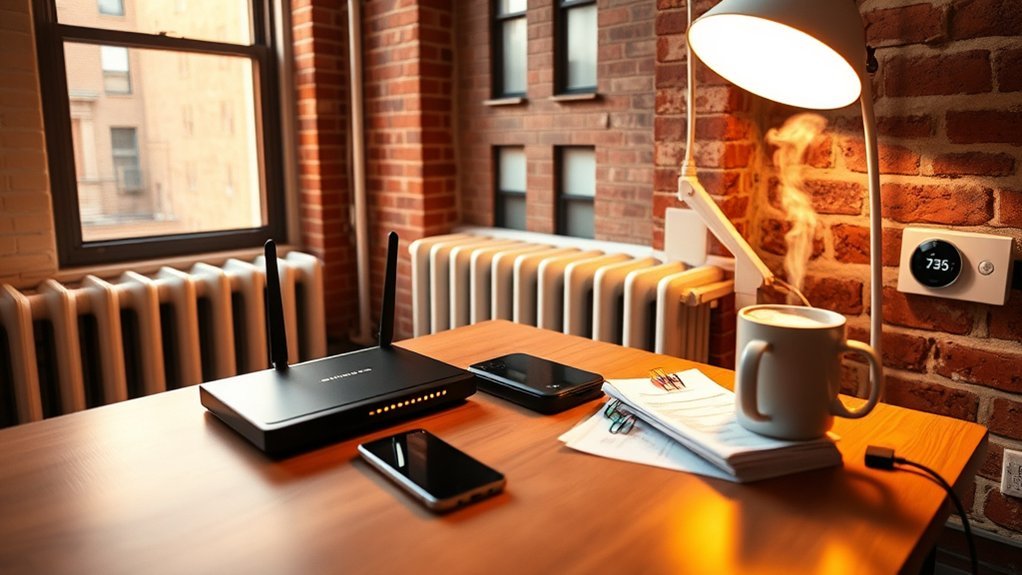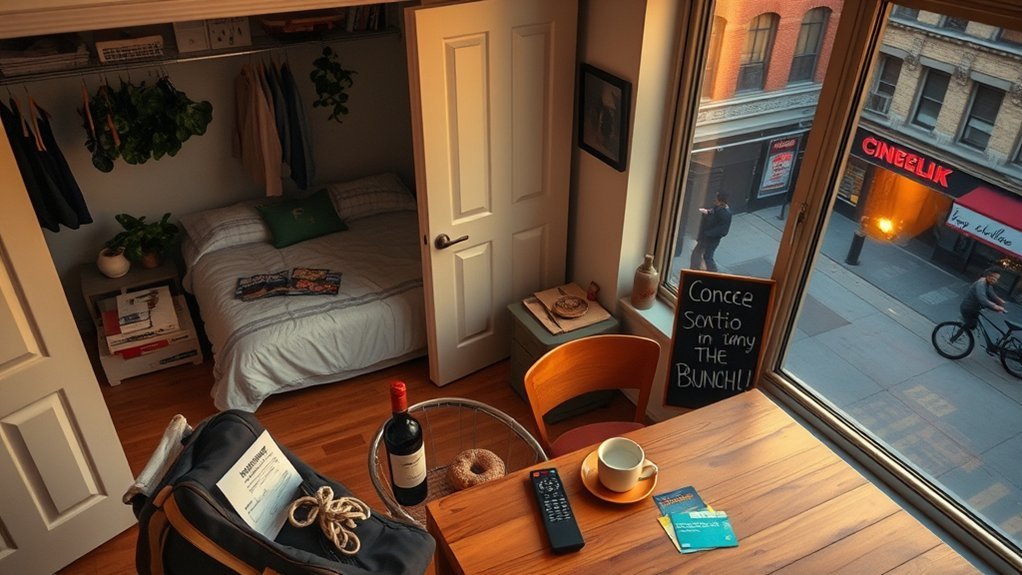If you’re planning to live in New York, you’ll want a clear, realistic budget that separates fixed housing costs from everyday essentials. Rent will usually dominate your monthly spending, but utilities, groceries, transit and healthcare quickly add up too. I’ll show typical totals for singles and families, neighborhood rent ranges, and practical ways to cut costs so you can decide what to prioritize next.
Monthly Budget Breakdown for a Single Person and Family of Four

Because New York’s costs skew well above the national average, you should expect a monthly budget that reflects steep housing and everyday expenses: a single person typically needs about $4,130 a month while a family of four averages roughly $8,925.
Because New York runs well above the national average, plan for high monthly costs: about $4,130 single, $8,925 family.
When you break down the average monthly cost, housing expenses and rent in New York dominate: one-bedroom and two-bedroom rents push your baseline high. For a single person, exclude rent and plan roughly $1,238 for essential expenses — groceries, utilities, and incidentals — plus transportation costs like a $132 unlimited pass if you commute.
For a family of four, essential expenses scale up: groceries and utilities rise substantially, and childcare or extra transport adds to the monthly budget.
You should prioritize forecasting fixed housing costs, then allocate remaining funds to groceries, utilities, transportation costs, and an emergency buffer so your household can absorb rent fluctuations and seasonal spikes without jeopardizing stability.
Rent and Housing Costs by Apartment Size and Neighborhood

Housing is the biggest line item you’ll face, so after sizing a monthly budget the next step is to examine rent by apartment size and neighborhood to see where you can realistically live.
You’ll see stark differences: the average rent for a 1-bedroom in NYC is about $4,929 and a 2-bedroom averages $7,299. Manhattan pushes those numbers higher — a typical 1-bedroom there runs roughly $8,833.
The overall median rent across the city is $3,400, but neighborhood choice drives that variance. If you need affordability, target neighborhoods like Harlem, Bedford-Stuyvesant or outer borough areas where rents can start near $2,200 in places such as Bensonhurst.
Housing costs will dominate your monthly budget, and renting is far more common than buying given sky-high home prices — the average home price is about $1,666,613.
Balance apartment size against location: smaller units in central neighborhoods cost more, while larger units farther out can stretch your dollar.
Utilities, Internet, and Cell Phone Expenses

You’ll usually pay $150–$250 a month for basic utilities in NYC, with costs rising for larger households or heavy AC use not always covered by rent.
Expect to add about $20–$50 for high‑speed internet and roughly $141 for a typical cell phone plan.
Together, these recurring charges can materially affect your monthly budget, so factor them into housing decisions and cost comparisons.
Typical Monthly Utilities
Monthly utility, internet, and cell phone bills in New York typically add up faster than renters expect, often ranging from about $150–$250 for basic utilities plus $20–$65 for internet and $20–$141 for cell service.
You’ll find average monthly utility costs vary with household size and usage; basic utilities like water, electricity, and gas may be included in rent, yet you’re often responsible for electricity, cooling, gas and garbage fees.
Treat internet services and cell phone plans as separate line items when building your household budget. Because combined expenses can exceed $300, track meter readings, set thermostats sensibly, and compare providers.
Small changes in usage or plan choice will noticeably affect essential utilities and total monthly expenses.
Internet and Mobile Plans
After you account for basics like water and heating, don’t forget that internet and mobile service can noticeably raise your monthly bills.
You’ll find internet service in New York City runs about $20–$50 depending on speed and service provider, while cell phone plans typically fall between $20–$40.
Together, internet and mobile add roughly $124.08 to your monthly household budget, though your actual monthly phone bill may be higher when other telecommunication expenses are included.
- Compare speeds and promos from each service provider to hit your target average monthly cost.
- If you’re cost-conscious, choose lower-tier cell phone plans and bundle cautiously.
- Track your monthly phone bill and negotiate or switch providers annually.
- Factor these lines into overall utility bills when budgeting.
Grocery Prices and Money-Saving Shopping Tips

Because grocery prices in New York are about 16.4% higher than the national average, you’ll want a deliberate plan to keep food costs under control. The typical single-person grocery budget runs $400–$500 per month, and basic items like a 1.5L bottle of water ($2.52), 1L of milk ($1.49), and a dozen eggs ($5.22) illustrate how quickly expenses add up.
Focus your monthly grocery budget on essential food items and cut waste: plan meals, use shopping lists, and buy versatile staples in bulk when possible. Compare stores—budget supermarkets often beat corner prices at local bodegas for staples, though bodegas can fill last-minute gaps.
Visit farmer’s markets for seasonal produce; you can sometimes get fresher items for less than chain stores. Track unit prices to spot real bargains and use loyalty apps, coupons, and store-brand alternatives.
These money-saving tips help offset elevated grocery prices so you can meet nutritional needs without overshooting your food costs.
Transportation Costs: Public Transit, Cars, and Parking

Transportation in New York can be economical if you rely on public transit—single subway or local bus rides cost $2.90 and a monthly unlimited MetroCard is $132—yet driving brings far higher recurring expenses: basic car ownership runs $250–$400 per month before gas and parking.
Gas averages about $4.02/gal, and parking in Midtown adds roughly $562 each month, so weigh commute frequency, parking needs, and flexibility when choosing between transit and a car.
You’ll save on transportation expenses if you use public transportation regularly: the subway fare and express bus fare ($7) are predictable, and the monthly unlimited MetroCard caps your transit spend.
Car ownership boosts monthly costs with insurance, maintenance, and registration, while gasoline prices and Midtown parking push totals higher.
Calculate commute distance, time value, and parking costs against convenience. If you rarely drive, keep a car-sharing or rental option instead of full-time ownership to limit avoidable monthly costs.
- Compare subway fare vs. express bus fare.
- Factor monthly unlimited MetroCard savings.
- Add gasoline prices into car ownership math.
- Include Midtown parking in monthly costs.
Healthcare, Insurance, and Other Essential Services

While New York offers world-class hospitals and clinics, you should expect healthcare and insurance to take a sizable bite out of your budget: individual annual medical costs average about $4,195 and single premiums run near $9,173, with family premiums and expenses rising to roughly $26,355 and $12,452 respectively—figures well above national averages—so factor higher doctor visit and dental fees (about $184 and $173) and explore city-operated clinics and plan options to limit out-of-pocket spending.
Expect higher-than-average healthcare costs in New York—budget for steep premiums, doctor and dental fees, and use city clinics.
You’ll want to budget around these healthcare premiums and medical costs into your monthly plan; divide annual totals to get an average monthly cost for clearer cash-flow management.
Don’t forget essential services beyond medical care: basic utilities usually add $150–$250 monthly to living expenses.
Use city-operated health clinics for preventive care and low-cost services, compare insurance plans each enrollment period, and prioritize an emergency fund for unexpected doctor visits or procedures to avoid disruptive financial shocks.
Entertainment, Dining Out, Fitness, and Leisure Costs

Expect to budget roughly $150–$200 a month for entertainment in New York City, since leisure activities here tend to cost more than elsewhere. Dining out, movies, and museums can add up quickly — a mid-range three-course meal for two is about $137.50, a cinema ticket runs near $18, and museum entry (like MoMA) is about $25.
You’ll weigh restaurant prices against cheaper options: a McMeal is roughly $12. For fitness, gym memberships range from $15 to $275 monthly, so decide between premium studios and basic gyms. You’ll also use outdoor leisure to offset costs—over 1,700 parks provide free fitness opportunities.
Integrate these choices into your monthly budget by prioritizing what you value most.
- Track entertainment costs monthly to prevent overspending.
- Mix dining out with budget meals to control restaurant prices.
- Compare gym memberships versus outdoor fitness opportunities.
- Use free or discounted museum fees and off-peak cinema tickets.
Frequently Asked Questions
How Much Is the Monthly Cost of Living in New York?
You’ll pay roughly $4,130 monthly for a single person; plan Average expenses around that, with Housing prices high, Utility costs, Grocery prices, Transportation fees, Entertainment budgeting, Dining out, Health insurance, Education costs, and Savings strategies included.
How Much Do You Need a Month to Live Comfortably in New York?
You’ll need about $4,130 monthly to live comfortably; use a cost breakdown covering housing options, transportation expenses, grocery prices, dining out, entertainment costs, utility bills, health insurance, childcare expenses, and saving strategies to plan effectively.
Is $5000 Enough to Live in New York?
Yes — you can, but it’s tight: Living expenses hinge on Rent prices, Grocery costs, Transportation fees, Utility bills, Dining out, Entertainment options and Healthcare expenses; weigh Work opportunities and Lifestyle choices, and you’ll need strict budgeting.
Is $40,000 Enough to Live in NYC?
No, $40,000 likely won’t cover NYC comfortably; you’ll need lifestyle adjustments, seek affordable neighborhoods, use public transportation, pursue job opportunities, cut dining costs and entertainment expenses, apply budgeting tips, savings strategies, and rigorous financial planning.
Conclusion
Living in New York can strain your budget, but you can control the impact by prioritizing rent, tracking essentials, and choosing affordable neighborhoods—so what’s your plan for balancing quality and cost? Start by locking in housing as a fixed expense, then allocate for utilities, groceries, transport, healthcare, and modest entertainment. Cut spending with smarter shopping, transit choices, and insurance comparisons. With disciplined budgeting and practical trade-offs, you’ll manage city life without constant financial stress.


